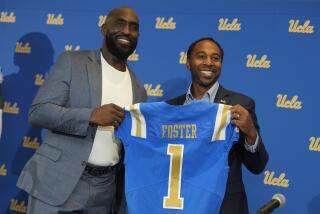UCLA’s Terasaki Denies Violation of School Rules, Misuse of Funds
- Share via
SACRAMENTO — UCLA Prof. Paul I. Terasaki disputed on Thursday a legislative audit’s conclusion that he violated university conflict of interest rules, in the process misusing more than $500,000 in public funds.
In his first interview since UCLA identified him a day earlier as the subject of the audit, Terasaki acknowledged that it was his idea to assume manufacture from UCLA of the profitable medical procedure he developed more than 20 years ago as a faculty member. That 1984 action led to an investigation by Auditor General Thomas W. Hayes that uncovered the purported irregularities.
Terasaki, a renowned authority on tissue transplants, said he sees nothing wrong with profiting from a process he developed on university time.
“Yes, it was my own proposal,” Terasaki said, adding, “I don’t think (Hayes’ criticism) was a fair statement.”
Terasaki also maintained that a $500,000 payment he made to the university after the state investigation into the relationship between the university and two corporations he owned “was not for any misuse of funds.”
Hayes’ allegations are based on a premise that the university was entitled to share in the profits from discoveries made by Terasaki on state time. Because the university received no money for the use of Terasaki’s technology between 1984 and this year, Hayes characterized the $500,000 payment in part a “recovery” of profits UCLA should have received.
Terasaki and UCLA administrators contend, however, that the $500,000 did not represent money lost by the university through Terasaki’s activities but was simply a fee paid to UCLA for the rights to a device the professor developed.
The device, known as the human lymphocytic antigen (HLA) tray, aids surgeons seeking to match donated organs with patients awaiting transplants.
Terasaki said, however, that a $13,187 payment he made to UCLA was to compensate for employees of his companies who inappropriately remained on the university payroll. “The $13,000 or so was for sick leave and benefits that people had taken,” Terasaki said.
Proposed Transfer
As director of UCLA’s tissue typing laboratory, Terasaki had overseen the university’s manufacture and sale of the trays since 1970.
Until 1982, the federal Food and Drug Administration permitted only UCLA and the National Institutes of Health to manufacture the trays. After the trays’ manufacture was deregulated five years ago, Terasaki said, he proposed that UCLA transfer the business to private companies he would control, One Lambda Inc. and Micro-drop Inc.
Although the marketing of the trays was turned over to Terasaki’s for-profit companies in 1984, the professor acknowledged that he continued until this year to use university employees, equipment and laboratory space for the trays’ manufacture. “We continued doing the same thing” done before the production was transferred to his private company, he said.
State auditors, alerted by an anonymous telephone tip, found that this arrangement, carried out with the approval of Terasaki’s superiors, violated state conflict-of-interest regulations.
UCLA Vice Chancellor Albert A. Barber had suggested that the generous arrangement with Terasaki was motivated by a desire to keep the distinguished scientist on the UCLA faculty. Asked whether he had considered taking his research elsewhere, Terasaki said: “Not directly.”
Barber said Thursday, “Given the care we took, I think we are protected (from violations of conflict rules), and we still have Paul here.” Barber added that the device developed by Terasaki “was his baby. And you don’t give up your baby very easily.
“It was his association with tissue typing over two decades that made it impossible for him to think he would not be the world supplier of HLA trays.”
Barber said UCLA’s initial informal agreement turning the tray-making business over to Terasaki was a temporary arrangement maintained while the university and Terasaki negotiated a contract to cover the transfer of the rights. “We didn’t get to a decision in a timely way,” Barber said. “We should have been more expeditious.”
UCLA Buys the Trays
Under the arrangement, Terasaki remains director of the university’s tissue typing laboratory, which sells the biological components needed for the manufacture of the HLA trays to private companies, including those Terasaki controls. Those companies then manufacture the trays, which are still used in Terasaki’s research and are purchased by the university, Barber said.
In response to the state audit, a faculty committee, chaired by law professor Robert Goldstein, was appointed to oversee Terasaki’s research and guard against potential conflicts of interest.
Although Barber has taken issue with Hayes’ contention that Terasaki misappropriated university resources, he said the university would not contest the auditor general’s findings before the Legislature.
UCLA officials were unable to provide the exact value of the HLA tray business, but Barber said “it was running into the millions a year.” He said the money UCLA earned from the early years of the tray manufacture went to support Terasaki’s research.
Dr. Robert Gale, the UCLA researcher who led the medical team treating victims of the 1986 Chernobyl nuclear plant accident in the Soviet Union and an associate of Terasaki for almost 20 years, said on Thursday that Terasaki’s inventions “were in their day of considerable financial value. If Dr. Terasaki had wanted to make money, he certainly wouldn’t have remained on the faculty of the University of California.”
At Gale’s invitation, Terasaki joined the medical team in the Soviet Union, where his tissue-typing procedure was considered crucial in treating hundreds of accident victims.
More to Read
Sign up for Essential California
The most important California stories and recommendations in your inbox every morning.
You may occasionally receive promotional content from the Los Angeles Times.













